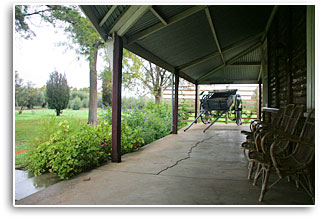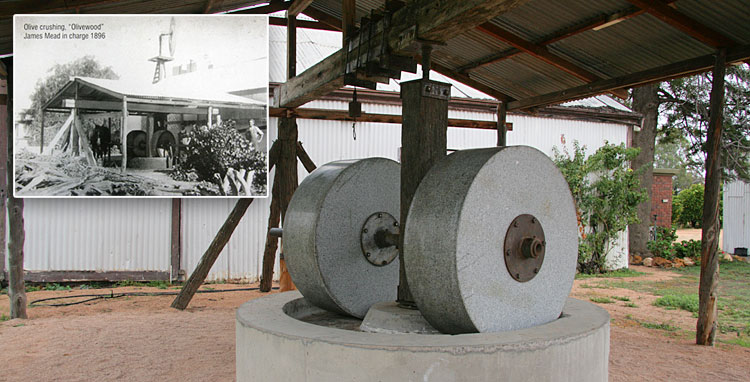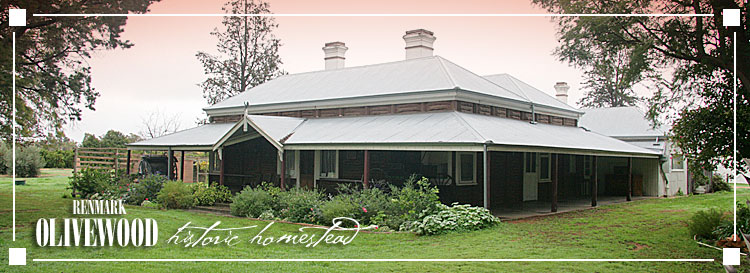
Olivewood, Renmark - built for Chaffey Bros irrigation in 1889
"Olivewood"
The beginning of an innovative irrigation project. The original property of some 60 hectares (140 acres) was owned by the Chaffey Brothers who were the first to commence colonized irrigation in Australia at Renmark.
Original House : built from Native Pine logs using the drop slot system. It housed Charles Chaffey and his family. The inside walls and ceiling are made of lathe and plaster and the floor is of Native Pine which is termite resistant. Much memorabilia of the past era is on display.
Museum : this building was originally the olive oil processing rooms but now displays a huge collection of about 3000 black and white photographs illustrating the early life in Renmark's and surrounding districts. There are also five volues of biographical essays on the early settlrs of Renmark.
Packing Sheds : originally Chaffey Brothers packing dried and citrus fruits.
The original property of "Olivewood" was the piece of land bounded by Renmark Avenue, 21st Street and the water course now called Bookmark Creek. the area was approximately 64.8 hectares.
The Chaffey Brothers were Canadian by birth and had previously founded successful irrigation settlements in California, USA. The brothers had been invited to Australia during the course of a tour of America by Alfred Deakin, a member of the Victoria Parliament of the day, to investigate the possibility of establishing an irrigation colony in Australia. The chosen land was what is known as Mildura. The Victorian Parliament decided to negotiate.
In the meantime, South Australian Premier Downer contacted the Chaffey Brothers and immediately made land available on the Murray. An agreement to establish Renmark as an irrigation colony was signed on 14th February, 1887. Making Mildura and Renmark the first irrigation region in Australia.
Charles Chaffey, a younger brother of George and W.B. Chaffey arrived in April 1888 and agreed to take over the Renmark operation. He selected land and gave plans for the building of his home to former Goolwa shipwright and carpenter A.F. Matulick. Charles returned to America and in October 1888 brought out his pregnant wife Ella and son. Ella remained in Adelaide to give birth to their second son and in January 1889 the family and servants travelled by the PS Corowa to Paringa. Here they resided in the Paringa Station Homestead situated on a hill close by the Paringa Bridge today, until they moved into their new home in the last months of 1889.
 Charles Chaffey chose a Canadian log-cabin style for his home; the walls of Murray pine logs had been laid horizontally supported by vertical pine posts slotted to receive them with deep shady verandahs added later. The kitchen was separated from the main house by a breezeway.
Charles Chaffey chose a Canadian log-cabin style for his home; the walls of Murray pine logs had been laid horizontally supported by vertical pine posts slotted to receive them with deep shady verandahs added later. The kitchen was separated from the main house by a breezeway.
The inside of the house was lined an sealed with lath and plaster and has wooden floors. There were also numerous cellars only one being still in use. "Olivewood" was classified by the National Trust of SA and is on the State Heritage List as well as the Commonwealth List.
The original selection had an extensive olive grove planted in 1890 (with complete building and olive mill processing olive oil), and lemon and orange orchards including the first naval orange tree brought to Australia and later on grapefruit. there were vineyards and zante currants and muscat grapes and orchards of peaches, apricots and pears. Then there were fields of wheat, alfalfa and lucerne for stock - the "Olivewood" dairy was a noted one - and windbreaks of eucalyptus to protect crops from wind and dust storms.
The family consisted of 6 children : George (1886 California), Charles (1888), Margaret (1889), Francis (1891), Harriet (1892) and Olive (1900). The home was run with the help of a cook, housemaid and a very competent governess; when the children were old enough they attended boarding school in Adelaide.
Ella Chaffey was an authoress of children's books. In 1896 The Youngsters of Murray Home was published and was based on here own children's lives at "Olivewood". The newspaper reviews of the day compared her favourably to the popular Ethel Turner.
The Chaffeys were well respected and involved in all aspects of the new settlement. In 1904 the family left to visit British Columbia, Canada and in their absence the mortgage over "Olivewood" was foreclosed due to crop failure. Household furnishings and personal property was sold by public auction. The furniture in the house, at present, has been provided by the National Trust of SA, as well as gifts from local people.
At the rear of the homestead, the original olive oil processing shed has been converted into a museum. On display are the 1878 wedding dress of a local pastoral family, river maps, badges, a complete early dental surgery, bottles and man items donated by the local community.
In a showcase is an original copy of the Red Book which was the 1888 Chaffey Bros. promotional publication giving information on the irrigation settlements to potential settlers and investors.
Photography collection
Of particular interest is the large collection of cameras as well as the professional equipment of Renmark's first photography business operated by J.C. Reiners from 1897 to 1939 when it was taken over by his daughter Janet until the 1950s. In the settlement's early years Mr Reiners would ride his bicycle laden with heavy photographic equipment over rough roads between Waikerie, Renmark and Wentworth. The Riverland owes a great debt to this early intrepid photographer for his images and the wide scope of his subject matter as he recored the new irrigation settlements, their growing townships as well as changing farming and pastoral areas.
On the left hand side of the homestead at a short distance, is a drying rack used for the drying of sultanas and currants. Adjacent to it is a brick hot dip where perforated tins holding grapes were dipped in a bath of caustic soda and caustic potash before being spread on the wire racks to dry. Dipping the fruit caused the skins to split and aided the drying and preservation process. Cold dips were introduced to lighten the colour of the fruit and used a mixture of carbonate of potash and olive oil emulsion. Both these pieces of fruit block equipment were constructed by "Olivewood" volunteers and were once standard features of most Riverland fruit properties for the half century of the 20th century.
The packing shed constructed in American style c1890 has a large overhead loft. Today it houses a citrus and dried fruit packing plant and associated items.
Olive Processing & Olive Crusher
Adjacent to this museum is a replica of the early Chilean mill which stood on this site in the 1890s. This replica crushing plant was constructed by "Olivewood" volunteers using recycled materials and working from a postcard size print from 1896. The project was assisted by a generous donation from the Renmark Paringa Council when it celebrated its centenary in 2004. Working re-enactments are staged on special occasions. One hundred of the original 1890 olive plantings are situated at the front of the property and provide a first class olive oil. In 1894 Renmark won First Prize for its olive oil at the Mildura Show.

This olive crusher is a replica of the one installed on the site by the Chaffey Brothers in the early 1890s.
This original machine was shipped to Port Adelaide and transported to Olivewood where it was used up until the 1940s to crush olives. Some of the original trees planted in 1890 can be seen at the front of the house. The quality of the oil produced was of a very high standard and won many prizes at local and interstate shows.
The original crusher was known as a 'Chilean Mill' probably because of its style, presumably patterned on mills used in Chile to crush metallic ores. It is more likely that the mill was made from Italian Granite. Italy had developed a large olive industry and most of the olive crushers used in Australia were made there. A horse hitched to a long beam operated the mill, a photo of it in operation is shown. Olives were put into the circular through by hand and the pulp from the crush then put onto special bags made of esparto, for pressing to produce 'first' (virgin oil) then 'second' pressing oil, the latter being of lower quality.
A previous owner of Olivewood, Chateau Mildura, sold the original crusher to a Mr Jack Friedman of Verdalian Olives, Mount Zero, near Horsham, Victoria in 1948 for £40 ($80). It is unclear how much work the crusher did on the Mount Zero property but it eventually fell into disuse and was presented to the Jardwa Apex Club of Horsham in 1969. The club set up stones as a feature in front o their club rooms on the bank of the Wimmera River in Horsham.
The Renmark Branch of the National Trust Renmark first learned of the location of the historic olive crushing stones in 1999, after searching for several years. Efforts to obtain their return to Olivewood through the Horsham Council and the Jardwa Apex Club eventually proved unsuccessful. The mill now resides on the property named Mount Zero, near Horsham where it has been set up by the Seymour family to operate symbolically as a tourist attraction in the café style area. The stones are still the property of the Jardwa Apex Club which has loaned them to the Mount Zero proprietors to help foster the olive industry in the district.
The property has been in private ownership and a large portion of it sold to the SA Housing Trust before it was acquired by the National Trust in 1979. Today the orchards are planted to Valencia and Navel oranges and there are olive groves of varying ages.
The Renmark branch of the National Trust is proud of the fact that theirs was the first branch established in SA in 1956. The branch had occupied two museums in the town before "Olivewood" was acquired and where the history of irrigation could be showcased along with the growth of Renmark as the first colonised irrigation settlement in Australia.
"Olivewood", which is considered worthwhile preserving for future generations, because of its interest both architecturally and historically, is situated on the corner of Renmark Avenue (Sturt Highway) and 21st Street. The main entrance is from Renmark Avenue along the palm lined drive. This is closed to vehicles however there is parking for cars and buses from the 21st Street approach.
- Olivewood's gracious gardens provide an ideal setting for a garden wedding or a beautiful back drop for wedding photos.
- Tea, coffee and biscuits are available with orange juice fresh from the orchard when in season.
- Light meals, morning and afternoon teas for groups by appointment.
- A selection of books, postcards and souvenirs are on display together with olive oil processed locally from our own trees and bottled, corked and labelled by our volunteers.
Opening Times
Thursday and Monday 10am-4pm
Closed Tuesday and Wednesday
Groups by Appointment - Phone (08) 8586 6175
Email: olivewood.renmark@gmail.com
Prices
Adults....$7.00
Concession....$5.00
Students....$3.00
Family (2 Adults & 2 Children)....$15.00
Coach Loads....$5.00 per person
Discover: Renmark | Paringa | Mildura | Riverland
Of related interest: Chaffey Trail Mildura | Irrigation of the Murray | Murray River Dams, Weirs and Locks
Source: Olivewood - National Trust, Renmark S.A.
Tell your friends you found this at murrayriver.com.au!
Copyright Discover Murray 2024. This site or any portion of this site must not be reproduced, duplicated, copied, sold, resold, or otherwise exploited for any commercial purpose that is not expressly permitted by DISCOVER MURRAY.






 A Celtic Christmas by A Taste Of Ireland
A Celtic Christmas by A Taste Of Ireland DREAMS FLEETWOOD MAC & STEVIE NICKS SHOW
DREAMS FLEETWOOD MAC & STEVIE NICKS SHOW The Royal Edinburgh Military Tattoo 2023 - Arts On Screen
The Royal Edinburgh Military Tattoo 2023 - Arts On Screen Angove Family Winemakers Art Exhibition featuring Wendy Neal
Angove Family Winemakers Art Exhibition featuring Wendy Neal
